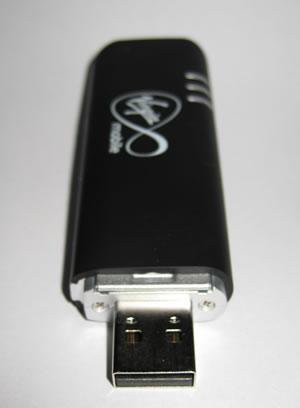 3G data dongles are all over the place these days.
3G data dongles are all over the place these days.
Virgin’s is manufactured by Huawei (who seem to be the vendor of choice for 3G dongles), it’s actually a Huawei E160, (background on Huawei) for those that care.
It’s a USB stick which plugs into any spare USB port. When plugged in, as well as being a 3G dongle, it appears to the operating system as as CD as well which contains the software to drive the dongle.
The system works on both Windows and MacOS X and the OS specific software appears when active on that OS. On Windows there’s a standard Autorun file which automatically installs the software when the dongle is plugged in – Neat.
As an added feature, the dongle also has a slot for a MicroSD card which appears as another drive (removable media) on Windows and MacOS X.
Compared to other dongles (well specifically the Huawei E220 and brethren) it’s very svelte at 75 x 25 x 12mm and weighs a mighty 50g. There’s an end-cap that covers the USB plug. The Virgin variant comes in black and has the Virgin logo on it in shiny silver.
The packaging is huge for such a little device, but the box contains a SIM, some manuals and a USB extended cable.
The dongle itself has 3 indicator lights to show what it’s doing. If the LED is green, it’s connected to GPRS/E.D.G.E, if blue then 3G and cyan, you’ve got a HSDPA connection.
Reliability
The dongle seems pretty reliable (Virgin is an MVNO on top of T-Mobile) and connections held while browsing the web, reading Email etc.
It does what it says on the tin.
Though the dongle was only tested in London, a HSDPA connection was maintained for several hours which achieved a maximum download speed of 150.2KB/s and a maximum upload speed of 14.7KB/s.
Skype didn’t work that well, text IM chatting was fine, but the audio was extremely choppy.
 Software
Software
Virgin’s software was working well until the dongle was unlocked (using DC-Unlocker at which point it started failing to establish a connection.
I guess there’s a lesson.
I managed to fix using Launch2Net, this does clever things on MacOS and makes it very easy to use mobile phones/dongles/data cards with a Mac.
Unfortunately it took a while to set-up to recognise Virgin’s network (as it assumed the E160 was using T-Mobile). With a bit of fiddling with the settings it sprung to life.
A big advantage of using Launch2Net is that is has some sensible defaults that will close the connection when it has been idle for a certain time, connected for a certain time, or after a certain amount of data usage.
Overall
The Virgin dongle is a neat device and the software works both on Windows and MacOS X (assuming you don’t mess with the hardware), the ability to use it as a microSD reader is an added bonus.
The dongle is just the right size to stick into a laptop – though it will cover neighbouring ports and it may be worth using the extension cord if that’s a problem.
Network connectivity is stable and reliable for applications such as web, it may not be so good for VoIP or video.
Scores
Easy of use: 83%
Build/size: 85%
Overall: 84%
Cost: £15 / month for upto 3Gb. 18 month contract